#narrowmouth
Explore tagged Tumblr posts
Text

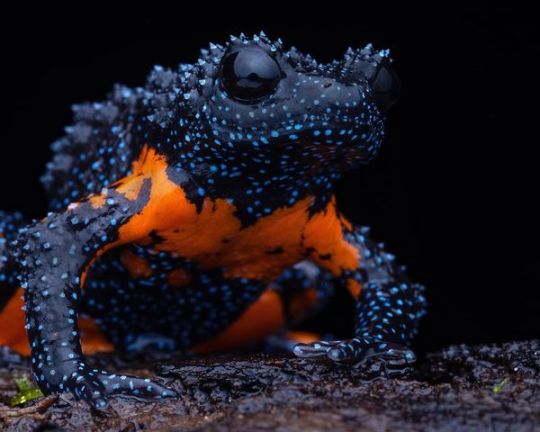
Indian Black Narrowmouth Frog aka "Space Frog" (Melanobatrachus indicus), family Microhylidae, Munnar, Kerala, India
photograph by Hadlee Renjith
29K notes
·
View notes
Text

Fast Fauna Facts #28 - Horned Land Frog (Sphenophryne cornuta)
Family: Narrowmouth Frog Family (Microhylidae)
IUCN Conservation Status: Least Concern
As its name suggests the Horned Land Frog differs from almost all other amphibians in that it doesn't require a water source to breed; females of this species lay their eggs among damp leaf litter, and following external fertilization a male will guard the eggs until they hatch. Instead of beginning life as aquatic tadpoles young Horned Land Frogs hatch as tiny but otherwise fully-developed frogs complete with functional limbs and lungs, and for a short period following their hatching they will continue to be protected by their father (often riding on his back until they're large enough to fend for themselves.) Endemic to the island of New Guinea, Horned Land Frogs primarily inhabit rainforests (although they may also be found in other forest habitats and occasionally in urban areas) and are mainly active at night, spending the day sheltering beneath logs and rocks or buried under leaf litter.
----------------------------------------------------------------
Image Source: Here
<-Previous (Royal Penguin)
499 notes
·
View notes
Text
Narrowmouth toads make the best sounds 🤎
66 notes
·
View notes
Text
Indian black microhylid frog - Melanobatrachus indicus
This stunning frog, on the internet better known as a galaxy frog, is endemic to southern India where it inhabits wet evergreen forests. Unfortunately, this species is endangered.
@hispaatra more FROGS ! ! ! :D


Description
Melanobatrachus indicus is a rare frog with a slender, elongated bodied of uniform width. The snout-vent length is reported as 24 up to about 32 millimetres. The head is wider than long and the short snout length is longer than the eye diameter and the interorbital distance. There is no canthus rostralis or cranial ridges. The pupils are circular and the eye diameter is greater than the distance between the eyes. There is no tympanum or parotid gland. The mouth has a cleft that extends towards the eyelid.
The skin on the dorsum of the head and body, and on the hind limbs are covered in tubercles. The arms, flanks, and ventrum are smooth.
The fingers are unwebbed and not dilated at the tips. The third finger is twice the length as the other fingers. The fourth finger is short. The hind limbs are about the same length as the snout-vent length with the thigh being shorter than the shank. The cylindrical toes have basal webbing and are undilated at the tips. The fourth toe is much longer than the third.
The dorsum is black with small white dots. The ventrum sometimes has a few scarlet blotches on the anterior region of chest that can extend to the upper arms and humerus. There are larger white dots on the belly. There is a broad scarlet band across the ventral surface of its thighs near to the groin area that can completely encircle the thighs. The aposematic coloration of the belly and limbs remain largely hidden when the species exhibits anti-predator, contraction behavior.
Distribution and habitat
It is endemic to wet evergreen forests of southern Western Ghats in Kerala and Tamil Nadu states of India at heights of 1000 to 1500 metres above sea level. It has been recorded from Anaimalai, Munnar, Palni hills, Periyar Tiger Reserve and Kalakkad Mundanthurai Tiger Reserve. It lives amongst leaf-litter, rocks and other ground cover of moist evergreen tropical forests.
~~~~~~~~~~~~~~~~~~~~~~~~~~~~~~~~~~~~~~~~~
Image sources:
1.
https://nl.pinterest.com/pin/364932376096529147/
2.
https://www.tumblr.com/herpsandbirds/752935777799946240/indian-black-narrowmouth-frog-aka-space-frog
~~~~~~~~~~~~~~~~~~~~~~~~~~~~~~~~~~~~~~~~~
Text reference
1.
https://www.iucnredlist.org/species/13032/166095464
2.
https://en.wikipedia.org/wiki/Melanobatrachus
3.
https://amphibiaweb.org/species/2229
#hyperfixation#biology#herpetology#Indian black microhylid frog#galaxy frog#Melanobatrachus indicus#frogs#frogblr#beloved mutuals#<3
18 notes
·
View notes
Note
youtube
His mouth is small and he must scream
not sure if I've got a better picture of it, but while in pursuit of a separate frog, found this one below. Couldn't have been bigger than a oak tree's acorn and initially misidentified it as a rock, didn't really know they could have proportions like that.

This is a Gastrophryne species. It is *probably* G. carolinensis, but it could also be G. olivacea. You'd have to have a photo of the belly to be sure. The belly of the former is generally dark with light spots, whereas that of the latter is generally grey to white without spots.
These are narrow-mouthed frogs, family Microhylidae, and members of the subfamily Gastrophryninae show off that narrow-mouthedness very well indeed. These kinds of proportions are pretty common in microhylids, and fairly rare in other families.
#WAAAAAAAH#narrowmouthed toad#I'm familiar with the eastern variety and I love them with my entire soul#They are so shaped#Youtube
96 notes
·
View notes
Text

Indian Black Narrowmouth Frog aka "Space Frog" (Melanobatrachus indicus), family Microhylidae, Munnar, Kerala, India
photograph by Hadlee Renjith
10 notes
·
View notes
Text

The Indian Black Narrowmouth Frog (Melanobatrachus indicus)
3 notes
·
View notes
Text


Indian Black Narrowmouth Frog aka “Space Frog” (Melanobatrachus indicus), T - female, B - male, family Microhylidae, Kerala, in the Western Ghats of India
photograph by Sandeep Das
#narrowmouth#space frog#melanobatrachus#microhylidae#frog#amphibian#herpetology#india#animals#nature
3K notes
·
View notes
Text

This red-shouldered hawk's family has nested in our yard for around 15 years now.
We have finches, sparrows, cardinals, wrens, chickadees, blue birds, robins, grackles, phoebes, tufted titmice, yellow-throated vireos, brown headed cowbirds, mourning doves, and mocking birds galore. Sharing space with the hawk family is a great horned owl, and theres a kestrel family a few houses down. We have green tree frogs, grey tree frogs, squirrel tree frogs, leopard frogs, southern toads, spadefoot toads, narrowmouth toads, and marbled salamanders. We have green anoles, five lined skinks, broadhead skinks, rat snakes, common watersnakes, and black racers. We have innumerable bugs including unique butterflies, moths, native bees, beetles, dragonflies, and spiders. We have mice, wood rats, squirrels, opossums, raccoons, armadillos, and sometimes larger mammals like deer and foxes. I've not seen any skunks in our yard or the neighborhood, but they're probably around too.
What makes our yard so attractive to wildlife? We don't do any yard spraying and we only use targeted insecticides for fire ants (invasive species) and mosquitos (dunks that only kill larvae, mostly we just avoid having standing water). My mom and I have finally convinced my dad to mow more minimally, and we try to id volunteer plants and protect them if they're native species. Our purposefully planted native and non-spreading ornamental plants get watered, but thats it. Volunteers get water if they're close to the other stuff, but they usually don't need it unless there's a serious hot and dry spell. We want ground cover, but we don't care about grass, so we don't mind the Carolina ponysfoot and vigina buttonweed over the backyard.
Wildlife likes our yard because we are lazy! We only mow as needed (we have dogs so needs to low enough to not totally hide snakes or be attractive to ticks), leave leaves, and don't spray poison everywhere (also because we have dogs and lawn chemicals increase canine cancer risk). We don't leave lights on outside on purpose and our dogs and cats are primarily indoors. Our next door neighbors also have primarily indoor pets, but they do leave lights on that aren't needed. Theres only one cat that is ever roaming, she's spayed, and she's kept inside most of the year. We've seen her less often in general since she's gotten older, and now allowing cats to roam is illegal in my county.
One of our next door neighbors mows excessively. One across the street has a full, obnoxious service that comes, poisons their yard, partially blocks the road, and makes a bunch of noise. The neighborhood our yard backs up at least at one point did mosquito spraying, which kills way more than just mosquitos.
We don't have an HoA, which helps, and we live outside city limits, but the city has no rules against leaving leaves anyway. Our yard never looks messy either. We put decorative stakes to mark volunteers we don't want mowed so it looks purposeful, and the dandelions and henbit and such honestly look prettier in the spring than a golf course lawn ever does.
The wildlife will find the pockets of refuge if we make them, and its pretty easy to make them if you have a yard while also campaigning for more ecologically friendly city planning, commercial development, and infrastructure. If you have time, you can also loiter in local/neighborhood groups on Facebook or nextdoor and leave comments that are anti-lawn, pro-wildlife, and anti-outdoor only/free roaming dogs and cats on any relevant posts. You can harass lawn and pest companies about how much the "services" they offer suck too if you want, but generally telling some one a fan for their patio will keep mosquitos off them just as well as expensive lawn spray without killing off butterflies works better.
"There's no wildlife here. The land is barren and stripped from farming chemicals"
I just saw two blue herons fly super low over our house, which means they've been fishing in the creek behind us, which means there's fish there. Which means there's bugs to feed the fish and algae to feed the bugs, which means the water and soil is worth something damnit.
Yes, I'm sorry the suburb isn't the grand, sweeping swath of uninhabited land that you so desperately crave but would learn to loathe, but saying that the land here is barren and that there's no wildlife here and that there's nothing to salvage- that's a You problem. Nature might be struggling, but against all odds it is at least trying.
17K notes
·
View notes
Text
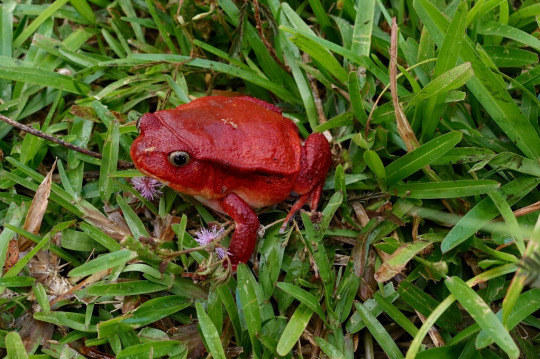
Tomato Frog (Dyscophus antongilii)
Family: Narrowmouth Frog Family (Microhylidae)
IUCN Conservation Status: Least Concern
Named for their rotund red bodies, Tomato Frogs are endemic to Madagascar where they are mostly found in wet, well-vegetated environments in the northeast. Spending the day buried beneath damp soil or leaf litter to avoid predation and dehydration, members of this species emerge at night to hunt for beetles, flies and other terrestrial arthropods, and respond to threats from nocturnal predators by inflating their bodies to appear larger and secreting a thick, sticky and mildly irritative substance from their skin, making them difficult for predators to bite or grab. Tomato Frogs breed following periods of heavy rainfall, and like almost all frogs they lay their eggs in water; males, which are smaller and paler than females, gather around suitable ponds or slow-moving rivers and streams during the night and produce low, quiet, grumbling calls, competing for the attention of females. If a female selects a male she will allow him to cling to her back and will carry him around for an extended period as she lays over 1,000 soft, transparent eggs which he fertilizes externally. Shortly after fertilization the eggs hatch into tiny, limbless, fully aquatic tadpoles that gradually develop limbs and lungs over the course of several months - after transitioning to life on land young Tomato Frogs are initially dull brown or pale yellow, gradually developing a redder colouration until they reach full maturity at 2-3 years of age.
------------------------------------------------
Image Source: Here
#tomato frog#Tomato Frog#frog#frogs#amphibian#amphibians#zoology#biology#herpetology#wildlife#African wildlife#herpetofauna
194 notes
·
View notes
Text

Indian Black Narrowmouth Frog aka “Space Frog” photograph by Sandeep Das
0 notes
Text
Look, narrowmouth toad sounds are the best sounds. It's just science. And I caught this little lad in full song. 🥹
(I turned the volume of the clip down by 50% and they're still amazingly loud. I love it)
5/23/23.
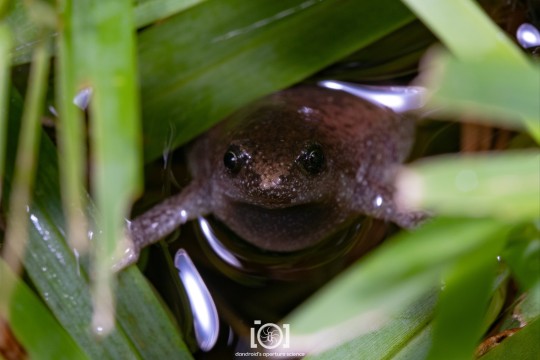
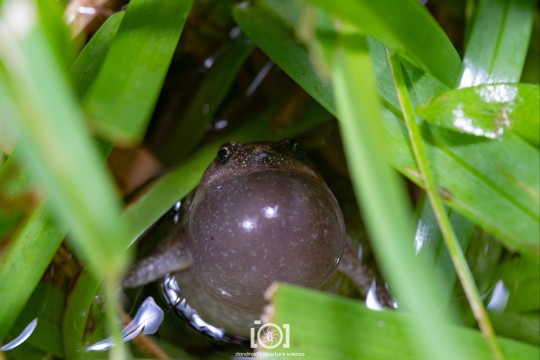
284 notes
·
View notes
Text

Check out this Eastern Narrowmouth (Gastrophryne carolinensis) I found today!! There were two of them under a rock pile.
1 note
·
View note
Text
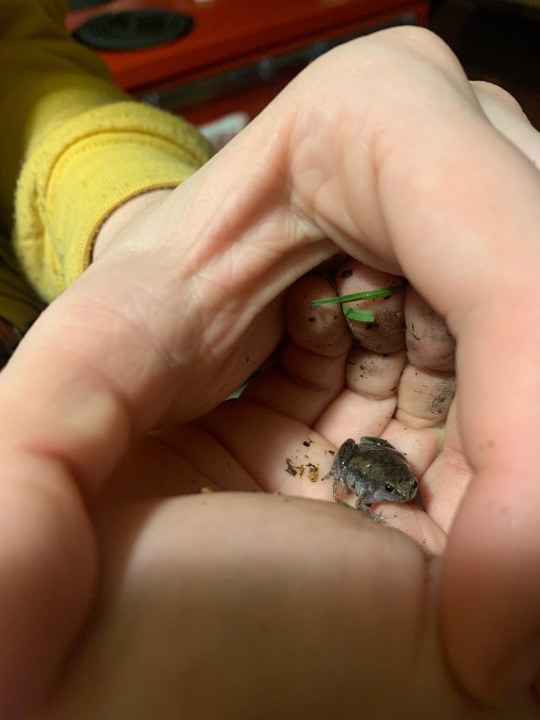
Sir you are illegally small
#frog blogging#frogcore#frogs#frog#toad#narrow mouth toad#narrowmouth toad#frog blog#frogblog#goblincore#cozycore#cottagecore#cute#cute frog#herping#herpetology#herptiblr#herpetofauna#toads#farmcore#like narrow mouths r already small but this is a FELONY#fox found him while collecting some dirt outside for something or other#she lit DUG HIM UP
3K notes
·
View notes
Photo
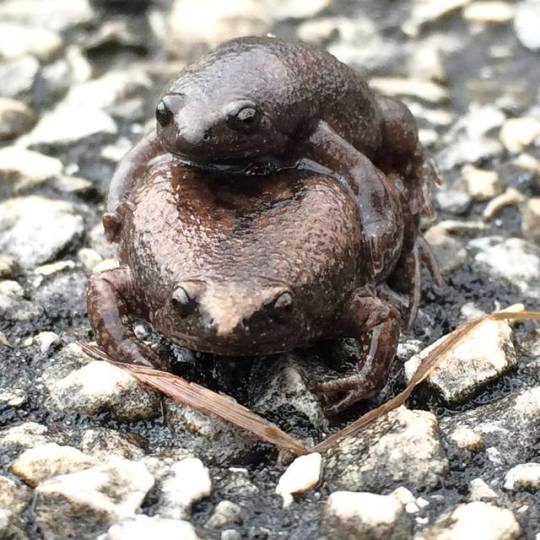

Eastern Narrowmouth toads (Gastrophryne carolinensis) take advantage of the heavy rains at Brazos Bend State Park in SE Texas.
photographs via: Texas Parks and Wildlife
254 notes
·
View notes
Text
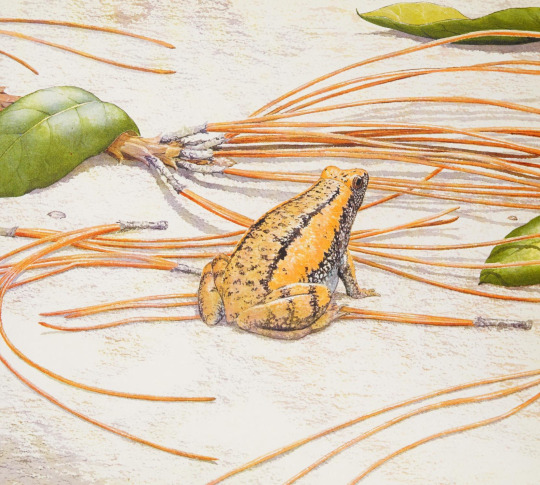
About Amphibians: A Guide for Children, written by Cathryn Sill and illustrated by John Sill, 2000.
148 notes
·
View notes